Peanut Butter
How to Make the Perfect Reese’s Filling at Home
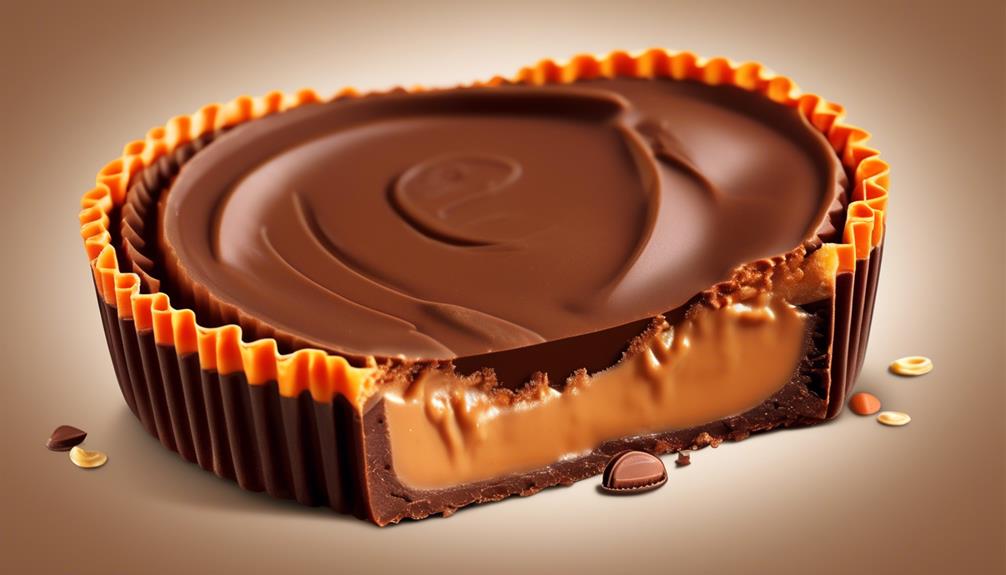
We are all familiar with the irresistible pairing of chocolate and peanut butter in a Reese’s Peanut Butter Cup. But have you ever stopped to think about what ingredients are used in that smooth filling?
The ingredients may surprise you. As we explore the key components of this beloved treat, we'll uncover the secrets behind its delectable taste and texture.
But there's more to it than just the ingredients – the process of crafting this iconic filling is equally intriguing.
So, let's dig into the fascinating world of Reese's Peanut Butter Cup filling and uncover what makes it a timeless favorite.
Key Takeaways
- Reese's Peanut Butter Cups have a rich history and are one of the top-selling candy brands in the United States.
- The key ingredients in the filling include creamy peanut butter, powdered sugar, salt, and corn syrup, which provide the iconic taste and texture.
- The flavor profile of Reese's Peanut Butter Cups is a combination of sweet and slightly salty flavors, with a smooth and creamy texture.
- The manufacturing process involves melting chocolate, creating the peanut butter filling, layering it in cupcake pan wells, and refrigerating to set.
The Origin of Reese's Peanut Butter Cups
Established by H.B. Reese in 1923, in Hershey, Pennsylvania, Reese's Peanut Butter Cups were originally known as Penny Cups and were sold for one cent before evolving into the iconic confection they're today. The rich and creamy filling of Reese's Peanut Butter Cups is a blend of smooth peanut butter, powdered sugar, a hint of salt, and just the right amount of corn syrup. This delectable mixture is meticulously prepared and set aside before being carefully piped into the waiting chocolate cups, creating the perfect balance of sweet and salty flavors in every bite.
The journey of Reese's Peanut Butter Cups has been nothing short of extraordinary. From its humble beginnings as Penny Cups to becoming the most beloved and sought-after candy, this confection has left an indelible mark on the world of sweets. The merger with Hershey Chocolate Corporation in 1963 and the subsequent acquisition by The Hershey Company further solidified its place in the hearts of chocolate and peanut butter enthusiasts.
Over the years, Reese's Peanut Butter Cups has expanded its offerings to include various flavors, sizes, and seasonal editions, captivating the taste buds of countless individuals and securing its position as one of the top-selling candy brands in the United States.
The Key Ingredients in the Filling

We'll start by discussing the key ingredients that make up the filling of a Reese's Peanut Butter Cup.
The creamy peanut butter is the main component, providing the distinct flavor and texture of the filling.
Additionally, the powdered sugar, salt, and corn syrup are crucial in creating the smooth and sweet consistency of the peanut butter filling.
Filling Ingredients
The key ingredients in the filling of a Reese's Peanut Butter Cup consist of creamy peanut butter, powdered sugar, salt, and corn syrup, which are carefully combined to create the signature creamy and sweet filling.
The creamy peanut butter serves as the primary component, providing the distinct nutty flavor and smooth texture.
Powdered sugar is added to sweeten the filling, while salt enhances the overall flavor profile by balancing the sweetness.
Additionally, corn syrup acts as a binder, ensuring that the filling holds its shape and retains its creamy consistency.
The precise combination of these filling ingredients is crucial in achieving the iconic taste and texture that Reese's Peanut Butter Cups are known for.
This blend of peanut butter, powdered sugar, salt, and corn syrup results in the delectably indulgent filling that complements the rich chocolate shell.
Flavor and Texture
Combining the creamy peanut butter, powdered sugar, salt, and corn syrup results in a filling with a rich, smooth texture and a delightful balance of sweet and slightly salty flavors, complementing the iconic Reese's Peanut Butter Cup. The powdered sugar contributes to the smoothness and sweetness of the filling, while the salt enhances the peanut butter flavor. This creates a delectable, slightly grainy texture with a sweet, nutty flavor that perfectly complements the chocolate coating. The corn syrup binds the ingredients together, resulting in a firm yet smooth consistency that complements the chocolate. Below is a table summarizing the flavor and texture elements of the Reese's Peanut Butter Cup filling.
| Flavor | Texture |
|---|---|
| Sweet | Rich |
| Slightly Salty | Smooth |
| Nutty | Creamy |
| Balancing | Delectable |
The Texture and Consistency
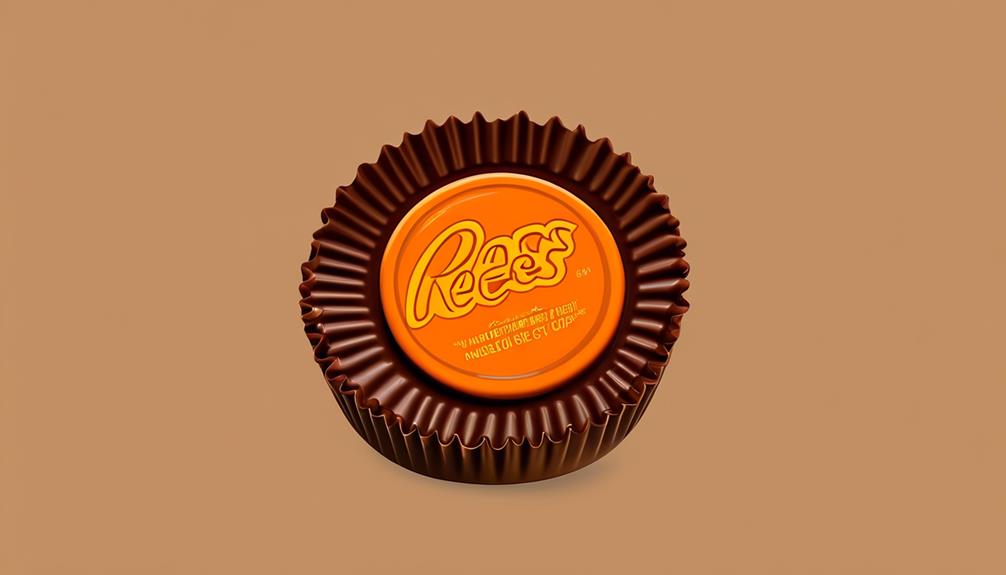
With a velvety and pliable texture, the filling in a Reese's peanut butter cup provides a satisfying contrast to the chocolate coating, delivering a burst of sweet and nutty flavors when bitten into. The creamy peanut butter filling is smooth and dense, creating a delightful sensation on the palate. It melts in the mouth, leaving a rich and indulgent taste that lingers.
The combination of powdered sugar, creamy peanut butter, and corn syrup gives the filling its firm yet yielding texture, making it easy to handle and enjoy. The filling is pliable and holds its shape well, adding to the overall experience of biting into a Reese's peanut butter cup. Whether it's the creamy or crunchy version, the consistency of the peanut butter filling remains consistently satisfying, offering a delightful contrast to the chocolate exterior.
The Nutritional Composition
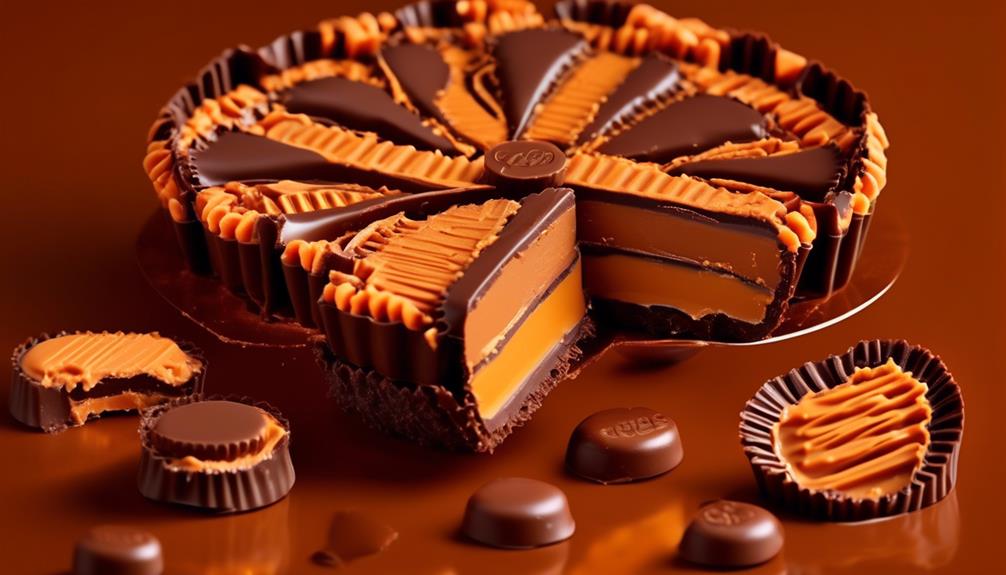
We need to consider the nutritional composition of Reese's Peanut Butter Cup filling to understand its impact on our diet.
The calorie count of 312 per serving and the total fat content of 18.8g are significant factors to analyze.
Additionally, we should pay attention to the levels of saturated fat, trans fat, and cholesterol to make informed dietary decisions.
Ingredients and Calories
The nutritional composition of the Reese's Peanut Butter Cup filling reveals that it contains approximately 276 calories per serving, with 18g of fat, 8g of saturated fat, and 20mg of cholesterol.
The filling also consists of about 25g of carbohydrates and 5g of protein, with 21g of sugar and 1g of fiber.
The creamy peanut butter, powdered sugar, salt, and corn syrup come together to create this delectable filling.
Despite its delicious taste, it's essential to consume it in moderation due to its relatively high fat and calorie content.
The combination of creamy peanut butter and sweet powdered sugar gives the filling its rich, indulgent flavor, while the salt and corn syrup balance the sweetness and enhance the overall taste of the Reese's Peanut Butter Cup.
Sugar and Protein
Pivoting from our discussion of the nutritional composition in terms of fat and carbohydrates, we now turn our focus to the pivotal components of sugar and protein present in the Reese's peanut butter cup filling.
The filling contains a significant amount of powdered sugar, which sweetens the peanut butter and provides structure. This addition of powdered sugar contributes to the overall sugar content of the filling.
Furthermore, the peanut butter itself adds a notable amount of protein to the filling, enhancing its nutritional composition. The combination of sugar and protein in the filling provides energy and can contribute to satiety.
When considering the nutritional aspects of the Reese's peanut butter cup filling, it's important to acknowledge the balance of sugar and protein, especially if incorporating it into a balanced diet.
The Manufacturing Process
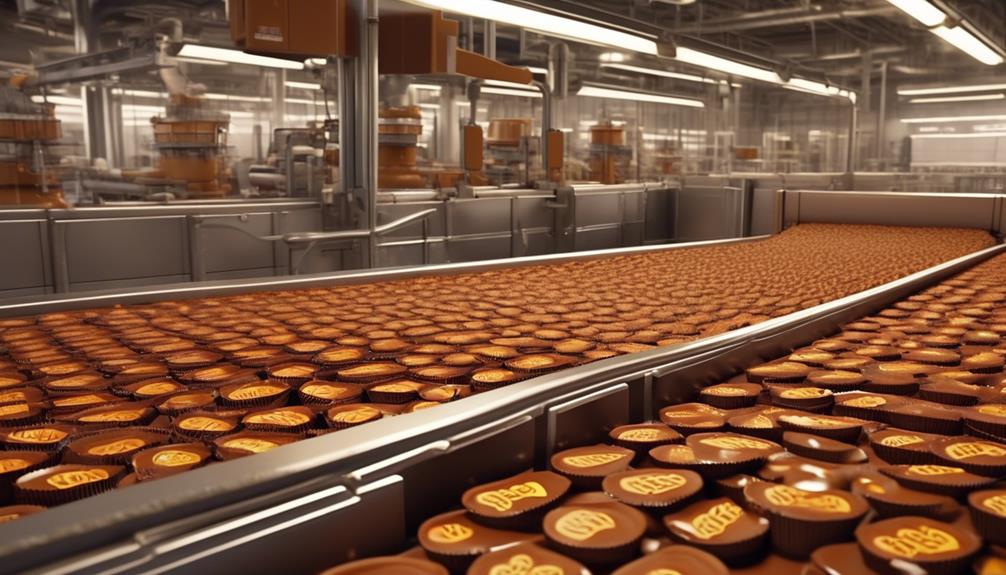
Melting the chocolate wafers is the initial step in the manufacturing process of Reese's Peanut Butter Cup filling. The process involves carefully spreading a ¼-inch thick layer of melted chocolate into cupcake pan wells, creating the base of the peanut butter cups.
The peanut butter filling is then meticulously prepared by microwaving the peanut butter and blending it with powdered sugar, salt, and corn syrup until the mixture is smooth and clump-free.
Once the chocolate layer is set, the peanut butter filling is added as a disk into each well, and then topped with another layer of melted chocolate to encase the filling.
The filled cupcake pan is then refrigerated for at least 30 minutes to allow the peanut butter cups to set.
This meticulous manufacturing process ensures that each Reese's Peanut Butter Cup has a perfect balance of chocolate and peanut butter, resulting in the irresistible taste that has made them a beloved treat for generations.
The Taste and Flavor Profile

When we explore the taste and flavor profile of the Reese's Peanut Butter Cup filling, we can break it down into three key points:
- The flavor components
- The balance of sweetness and saltiness
- The texture and consistency
These aspects play a crucial role in defining the overall sensory experience of this iconic treat. By examining each point in detail, we can gain a deeper understanding of what makes the filling so beloved and distinctive.
Flavor Components
The taste and flavor profile of a food product are shaped by a complex interplay of flavor components, including sweetness, saltiness, bitterness, and other key elements, which collectively contribute to the overall sensory experience. When it comes to Reese's Peanut Butter Cups, the flavor components play a crucial role in defining their delectable taste.
- Sweetness: The sweetness in Reese's Peanut Butter Cups comes from the chocolate and the sugar content in the peanut butter filling, creating a delightful and indulgent flavor.
- Saltiness: The saltiness in the peanut butter filling provides a savory contrast to the sweetness of the chocolate, enhancing the overall flavor profile with a hint of salt.
- Peanut Butter Flavor: The rich, nutty flavor of the peanut butter is a dominant flavor component, adding depth and a distinctive taste to the filling of Reese's Peanut Butter Cups.
Sweetness and Saltiness
The flavor components of Reese's Peanut Butter Cups, particularly the interplay between sweetness and saltiness, contribute significantly to their delectable taste and complex flavor profile.
The creamy peanut butter filling provides a rich, nutty sweetness that's complemented by the savory saltiness. This balance between sweet and salty creates a harmonious flavor experience that tantalizes the taste buds.
Additionally, the chocolate shell adds a layer of sweetness, while also offering a hint of bitterness that further enhances the overall flavor profile.
The combination of these elements results in a well-balanced and indulgent taste that has made Reese's Peanut Butter Cups a beloved treat for generations.
Understanding the intricate relationship between sweetness and saltiness is key to appreciating the delightful complexity of this iconic candy.
Texture and Consistency
To comprehend the texture and consistency of Reese's Peanut Butter Cup filling, it's imperative to analyze its composition and structural attributes.
- The filling combines creamy peanut butter, powdered sugar, salt, and corn syrup, resulting in a smooth and creamy texture with a slightly firm consistency.
- The creamy peanut butter provides a velvety richness, while the addition of powdered sugar and corn syrup contributes to the firmness, creating a perfect blend of smoothness and stability.
- When savored, the filling offers a delightful contrast to the chocolate coating, enhancing the overall experience with its creamy yet slightly firm texture.
This amalgamation of creamy peanut butter, powdered sugar, and corn syrup ensures a gratifying textural experience, adding depth to the overall indulgence of a Reese's Peanut Butter Cup.
The Popularity and Demand
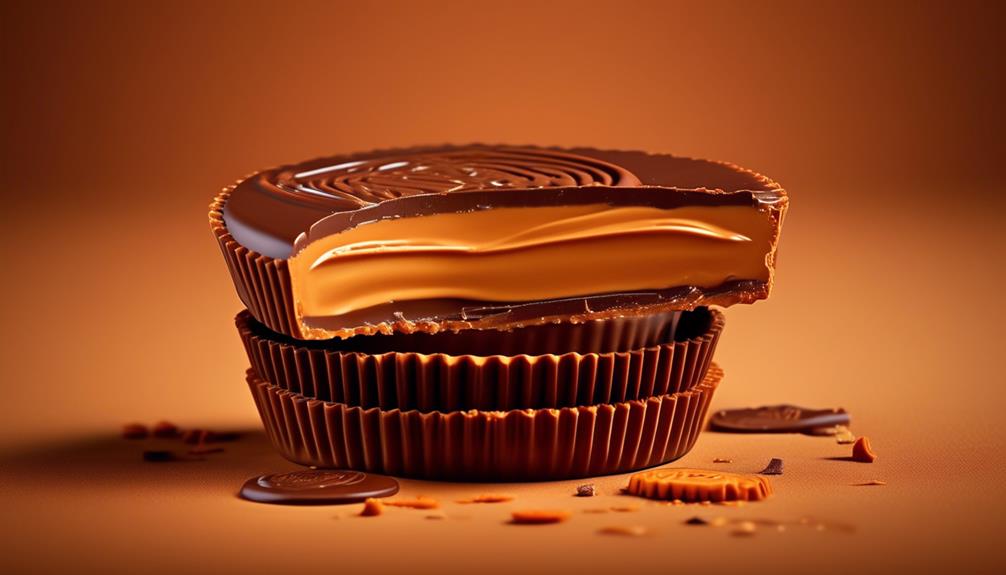
With its irresistible combination of chocolate and peanut butter, Reese's Peanut Butter Cups have become a globally sought-after and highly coveted candy treat. The unique filling, consisting of creamy peanut butter, powdered sugar, salt, and corn syrup, contributes to the distinct flavor profile that has captured the hearts of consumers worldwide. The popularity of Reese's Peanut Butter Cups can be attributed to the universal appeal of the peanut butter and chocolate pairing. This classic flavor combination transcends cultural and geographical boundaries, making it a beloved choice for consumers of all ages.
The demand for Reese's Peanut Butter Cups remains consistently high, with the brand offering a wide range of options, including seasonal and specialty flavors, as well as various sizes and shapes. This versatility caters to diverse consumer preferences, ensuring that the product maintains its popularity throughout the year.
The widespread integration of Reese's Peanut Butter Cups into recipes and desserts further demonstrates its enduring allure, cementing its status as a cultural icon in the confectionery world. The brand's successful advertising campaigns and continued innovation have solidified the enduring demand for Reese's peanut butter products, making them a staple in the global candy market.
The Unique Selling Points
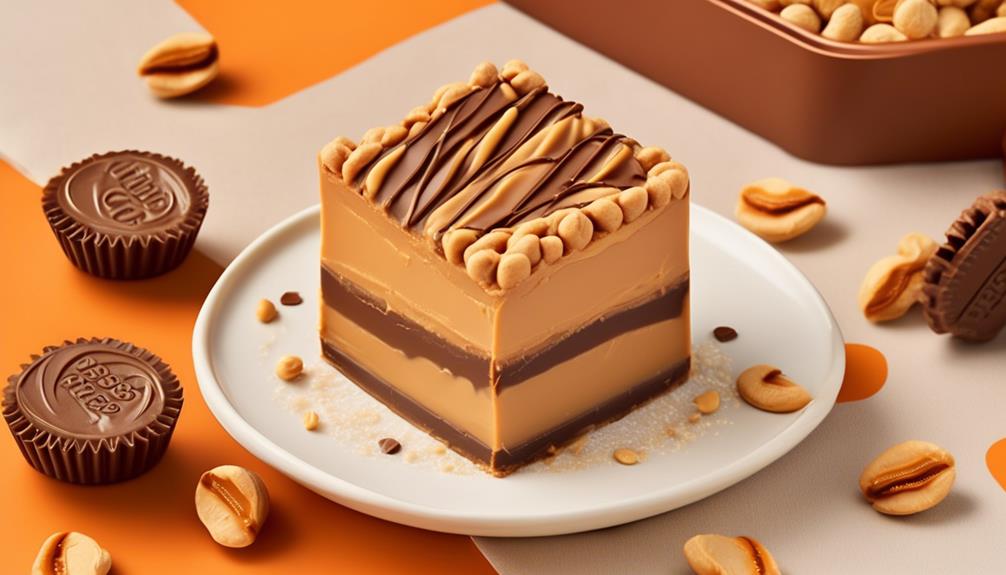
Boasting a quick and easy preparation process with only five essential ingredients, the Reese's Peanut Butter Cup filling offers a classic and indulgent flavor combination of creamy peanut butter and rich chocolate.
The simplicity of creating these peanut butter cups makes them an ideal choice for a quick and satisfying treat.
The timeless pairing of peanut butter and chocolate has solidified its place as a beloved flavor combination for consumers of all ages.
The ability to customize the filling with mix-ins and toppings allows for a personalized touch, appealing to those with specific flavor preferences.
The allure of Reese's peanut butter cups lies in their effortless assembly, nostalgic taste, and adaptable nature.
These unique selling points position the product as a versatile and convenient indulgence.
When consumers seek a familiar yet customizable treat, the Reese's peanut butter cup filling stands out as a top contender.
The Historical Evolution
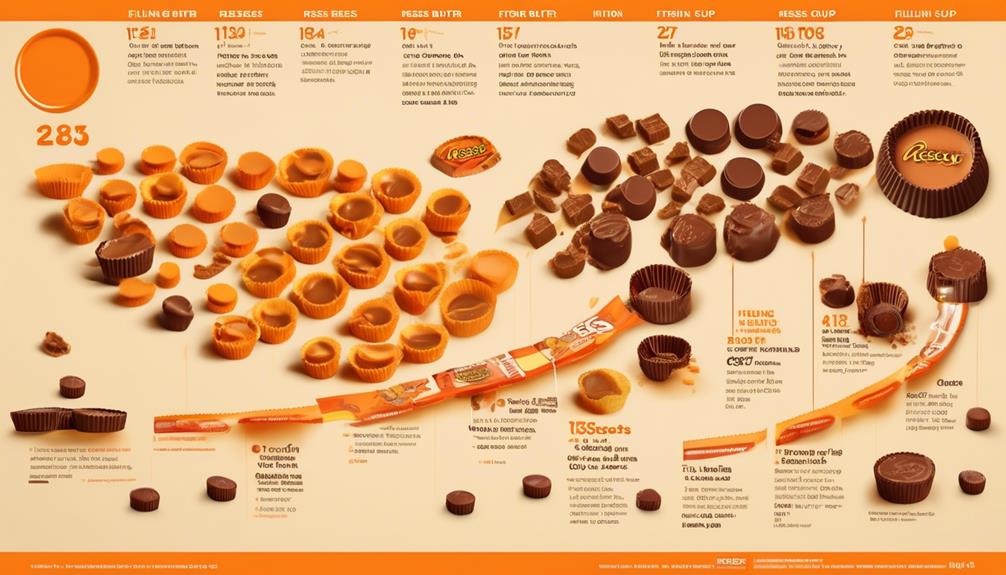
The historical evolution of Reese's Peanut Butter Cups reflects the brand's enduring popularity and innovation in the confectionery industry. Established in 1923 by H.B. Reese in Hershey, Pennsylvania, Reese's Peanut Butter Cups were originally named Penny Cups and sold for one cent. The popularity of Reese's Peanut Butter Cups led to a merger with Hershey Chocolate Corporation in 1963 and subsequent acquisition by The Hershey Company, paving the way for its widespread availability and continued success.
The product has evolved to include a diverse array of varieties and flavors. This includes dark chocolate, white chocolate, limited edition seasonal flavors, specialty flavors, and various size and filling variations, providing consumers with a wide range of options to suit their preferences.
In addition to the classic peanut butter cups, Reese's also offers other products such as the Crispy Crunchy candy bar, Fast Break candy bar, Plant-Based Peanut Butter Cups, Snack Bar, and Sticks, showcasing the brand's adaptability and commitment to innovation.
Over the years, Reese's has maintained its position as one of the top-selling candy brands in the United States through strategic marketing, memorable advertising campaigns, and collaboration with other brands. This has solidified its status as a beloved and iconic confectionery brand.
The Cult Following
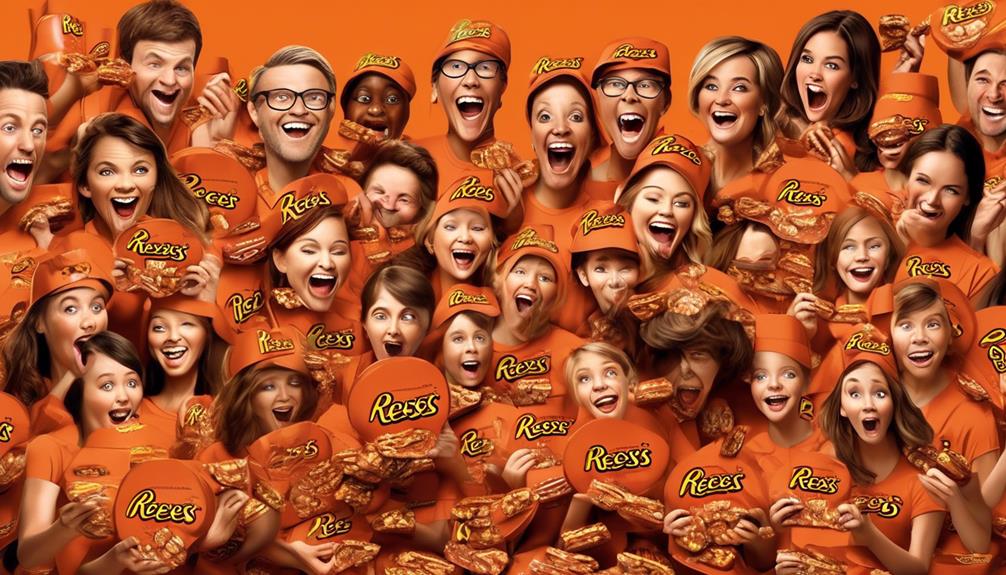
Reese's Peanut Butter Cups have cultivated a devoted and passionate following, characterized by a fervent loyalty and shared enthusiasm for the brand's unique and unconventional appeal. This cult following has arisen due to several key factors:
- Peanut Butter Adoration: The cult following has been driven by the deep-seated adoration for peanut butter. Reese's peanut butter cups are celebrated for their creamy and rich peanut butter filling, which has become a cornerstone of the brand's identity. This has resonated with individuals who have an unwavering fondness for the distinct flavor and texture of peanut butter.
- Shared Experiences: The cult following of Reese's peanut butter cups extends beyond mere enjoyment of the product. It has fostered a shared experience amongst its followers, who often engage in communal activities, discussions, and events centered around their love for the peanut butter cups. This sense of belonging and camaraderie has further solidified the cult following.
- Brand Loyalty: The brand's ability to maintain a consistent and high-quality product over the years has garnered unwavering loyalty from its followers. The unchanging, yet beloved, recipe for the peanut butter filling has played a pivotal role in sustaining this cult following.
The Secret Recipe Speculations

We've been pondering the secret behind Reese's Peanut Butter Cup filling, and it's time to explore the points that have been circulating in discussions.
The ingredients and flavors, the texture and consistency, and the manufacturing process are all critical aspects to consider when speculating about the secret recipe.
Ingredients and Flavors
Speculating about the secret recipe for Reese's Peanut Butter Cup filling leads to intriguing discussions about its distinctive flavors and ingredients. As we delve into the realm of the unknown, we can't help but ponder the exact blend of elements that create the iconic taste of this delectable treat. Our curiosity centers around the precise combination of:
- Peanut Butter: The primary ingredient, which brings a rich, nutty flavor and a creamy texture to the filling.
- Chocolate: The luscious, melted chocolate that enrobes the peanut butter filling, adding a layer of sweetness and depth to the overall taste.
- Powdered Sugar, Salt, and Corn Syrup: These elements come together to enhance the sweetness, balance the flavors, and provide the desired consistency to the filling.
The complex interplay of these ingredients results in the unmistakable and irresistible flavor profile of the Reese's Peanut Butter Cup.
Texture and Consistency
To achieve the desired texture and consistency for the peanut butter filling in a Reese's Peanut Butter Cup, the ingredients must be precisely combined and carefully shaped before being enrobed in melted chocolate. The mixture of creamy peanut butter, powdered sugar, salt, and corn syrup should be thoroughly stirred until achieving a clump-free consistency. The peanut butter filling is then shaped into disks and placed into the chocolate-filled cupcake pan wells. A spoonful of melted chocolate is then used to fully cover the peanut butter filling in each well before refrigerating. This meticulous process ensures that the peanut butter filling maintains its creamy texture and pairs perfectly with the chocolate layer.
| Ingredients | Texture and Consistency |
|---|---|
| Creamy peanut butter | Smooth and consistent |
| Powdered sugar | Clump-free and uniform |
| Salt | Balanced and well-distributed |
| Corn syrup | Even and cohesive |
Manufacturing Process
The meticulous process used to achieve the desired texture and consistency of the peanut butter filling in a Reese's Peanut Butter Cup is an essential aspect that leads to the secret recipe speculations surrounding its manufacturing process.
- Melting: The process begins with microwaving the peanut butter to achieve a smooth and creamy texture, ensuring it blends seamlessly with the other ingredients.
- Mixing: The addition of powdered sugar, salt, and corn syrup is carefully measured and stirred into the peanut butter to create a cohesive filling that holds its shape inside the chocolate coating.
- Layering: After the filling is added to the chocolate-filled cupcake pan wells, another layer of melted chocolate is poured over the top before the cups are refrigerated, allowing the layers to set into the iconic Reese's Peanut Butter Cup.
The manufacturing process involves precision and attention to detail to deliver the perfect combination of peanut butter and chocolate in every bite.
The Filling's Role in Recipes
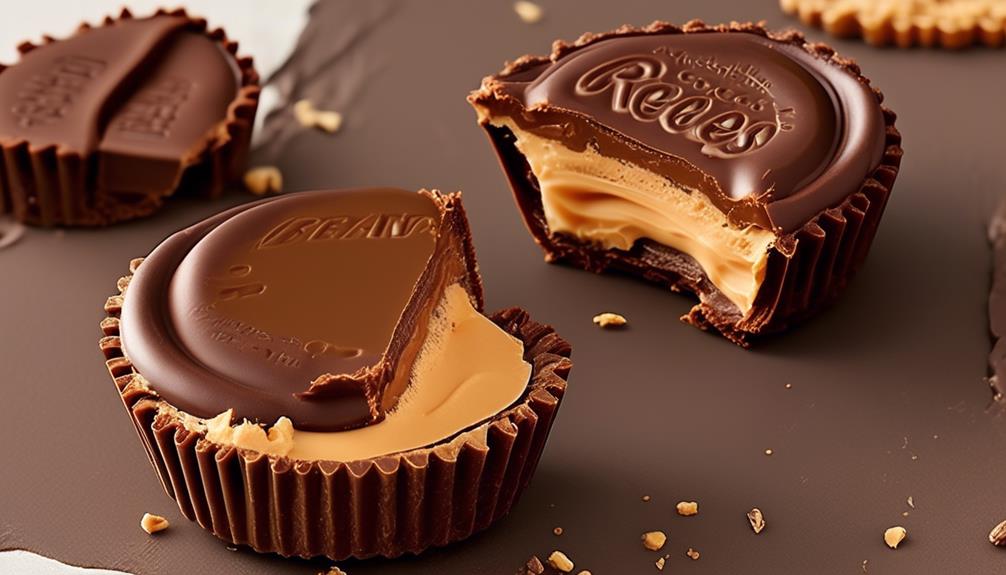
In recipe formulations, the filling of a Reese's peanut butter cup serves a pivotal role in achieving the desired flavor, texture, and consistency of the end product.
The creamy peanut butter, combined with powdered sugar, salt, and corn syrup, creates a sweet and savory flavor profile essential to the iconic taste of a Reese's peanut butter cup.
This unique filling also contributes significantly to the overall texture, providing a creamy and smooth consistency that complements the chocolate exterior.
The powdered sugar not only adds sweetness but also plays a crucial role in binding the ingredients together, ensuring a cohesive filling.
Additionally, the corn syrup is instrumental in establishing the desired texture and consistency, effectively contributing to the smooth and slightly firm nature of the peanut butter filling.
Understanding the interplay of these ingredients is essential for incorporating the filling into various recipes, as it not only provides flavor but also influences the texture and consistency of the final product.
This makes it a versatile and indispensable component in creating delectable treats with a distinct peanut butter and chocolate flavor.
The Filling's Global Appeal
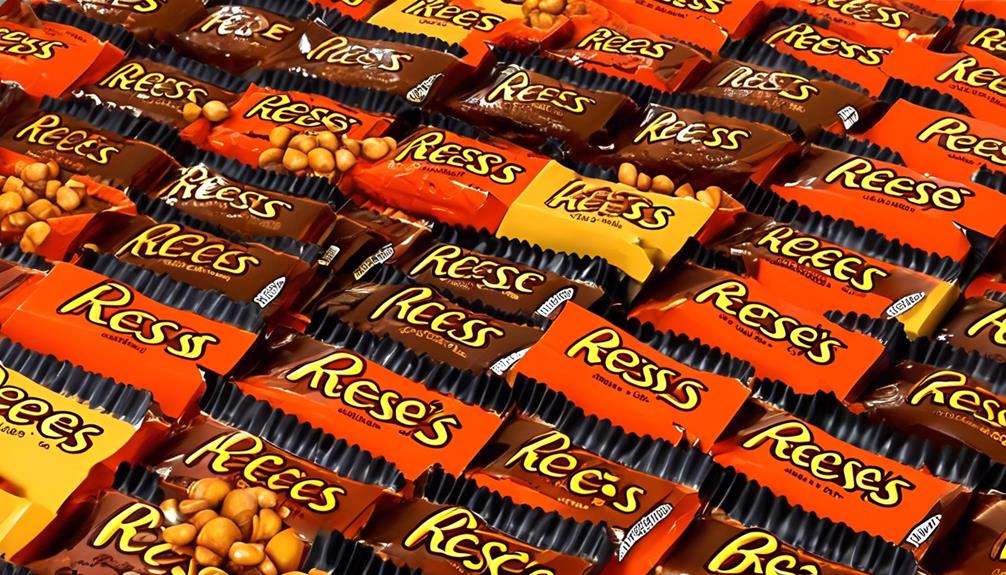
As we consider the global appeal of the Reese's peanut butter cup filling, it becomes evident that its iconic flavor combination and adaptable nature have contributed to its widespread recognition and popularity across diverse consumer markets.
- Classic Flavor Combination: The timeless pairing of peanut butter and chocolate in the filling appeals to a wide range of palates, transcending cultural and regional differences. This classic combination provides a familiar and comforting taste that resonates with consumers worldwide.
- Quick and Easy Preparation: The no-bake nature of the filling makes it a convenient choice for consumers seeking a delicious treat without the need for complex cooking techniques. This ease of preparation has contributed to its global appeal, allowing individuals from various backgrounds to indulge in its flavor without extensive culinary skills.
- Customizable with Mix-Ins and Toppings: The adaptability of the filling to incorporate mix-ins such as chocolate chips and various toppings allows for personalization, catering to diverse preferences and culinary traditions. This flexibility has played a significant role in its widespread acceptance and integration into international cuisines and confectionery offerings.
The Reese's peanut butter cup filling's global popularity is a testament to its ability to transcend borders and resonate with a wide spectrum of consumers, making it a beloved treat across the world.
The Future Innovations

Evolving at an exponential pace, future innovations are poised to reshape industries across the globe, incorporating cutting-edge technology and advancements to drive progress and efficiency.
In the realm of confectionery, the future of peanut butter cups holds exciting potential. With the advancement of 3D printing technology, confectionery manufacturers may soon be able to create custom peanut butter cup designs, allowing consumers to personalize their treats.
Additionally, the use of innovative ingredients and flavor combinations could pave the way for a new generation of copycat Reese's peanut butter cups, offering diverse options to cater to evolving consumer preferences.
Furthermore, advancements in sustainable packaging materials and production processes may lead to environmentally friendly packaging for peanut butter cups, aligning with the growing demand for eco-conscious practices. The integration of blockchain technology could also offer consumers unprecedented transparency into the sourcing of ingredients, ensuring quality and ethical standards are met.
As the confectionery industry embraces automation and smart manufacturing, the future holds the promise of enhanced efficiency and consistency in producing peanut butter cups, while also driving down costs and reducing waste.
These innovations are set to elevate the peanut butter cup experience, offering consumers a blend of tradition and cutting-edge technology.
Frequently Asked Questions
What Is the Main Filling in Reese's?
We're here to discuss the main filling in Reese's. It's a luscious blend of creamy peanut butter, powdered sugar, salt, and corn syrup.
We microwave the peanut butter, then mix in the powdered sugar, salt, and corn syrup until it's smooth. This heavenly mixture is combined with melted chocolate in a cupcake pan to create the classic Reese's Peanut Butter Cup.
After chilling, the filling sets, giving us that irresistible treat.
What Is a Reese's Peanut Butter Cup Made Of?
We love Reese's Peanut Butter Cups! They're made of creamy peanut butter, powdered sugar, salt, and corn syrup for the filling.
The peanut butter filling is created by microwaving the peanut butter, then mixing it with powdered sugar, salt, and corn syrup until smooth and clump-free.
The chocolate layers are made by melting milk chocolate wafers and creating a ¼-inch thick layer in each cupcake pan well.
Is It Real Peanut Butter in Reese's?
Yes, it's real peanut butter in Reese's. The creamy filling is made of peanut butter, powdered sugar, salt, and corn syrup. We mix these until fully combined and clump-free.
After pouring a layer of melted chocolate in each cupcake well, we shape the peanut butter filling into disks and place them on top before covering with more chocolate.
What Are Reeses Pieces Filled With?
Reese's Pieces are filled with a combination of peanut butter and a candy shell.
The peanut butter filling is made of creamy peanut butter, powdered sugar, salt, and corn syrup, giving it a smooth and sweet taste.
The candy shell provides a crunchy texture and adds a pop of color to the treat.
The combination of these elements creates the iconic flavor and texture of Reese's Pieces that we all love.
Conclusion
In conclusion, the creamy and sweet filling of a Reese's Peanut Butter Cup is a harmonious blend of peanut butter, powdered sugar, salt, and corn syrup, encased in a layer of milk chocolate.
This delectable combination creates a symphony of flavors and textures that has captured the hearts of chocolate and peanut butter lovers worldwide. Just like a well-composed piece of music, the filling in a Reese's Peanut Butter Cup is a delightful masterpiece that continues to captivate and satisfy its audience.
From sneaky childhood butter licks to penning some of our most popular articles, Jamie’s journey with butter has been lifelong. His culinary background gives him a unique perspective, allowing him to craft mouthwatering articles that educate and tantalize equally. Jamie’s travel adventures revolve around finding the world’s best buttery treats when he isn’t writing.
Peanut Butter
What Makes Peanut Butter Whiskey Unique?

So, you're curious about peanut butter whiskey? Well, it's certainly an intriguing concept, isn't it?
The idea of blending the rich, nutty flavor of peanut butter with the warmth of whiskey is something that piques the interest of many.
But how does it actually taste? Is it a gimmicky novelty or a genuinely enjoyable spirit?
Let's explore the world of peanut butter whiskey and uncover what makes it a standout in the realm of flavored spirits.
Key Takeaways
- Peanut butter whiskey offers a unique flavor profile, combining the rich, nutty taste of peanut butter with the smooth warmth of whiskey.
- It appeals to both whiskey enthusiasts and those with a sweet tooth, offering a velvety, nutty sweetness on the palate.
- With an initial aroma reminiscent of freshly ground peanuts, it provides a familiar and comforting warmth of whiskey on the finish.
- Peanut butter whiskey has gained popularity due to its exceptional taste, appealing to those who prefer sweeter alcohol options and expanding the flavored whiskey market in the United States.
Peanut Butter Whiskey: A Unique Flavor Profile
Peanut butter whiskey offers a unique flavor profile that combines the rich, nutty taste of peanut butter with the smooth warmth of whiskey, creating a distinctive and indulgent drinking experience.
The marriage of whiskey and peanut butter creates a surprisingly delightful fusion that appeals to both whiskey enthusiasts and those with a sweet tooth. This flavored whiskey introduces a whole new dimension to the world of spirits, challenging traditional notions of what whiskey can be.
The initial aroma is reminiscent of freshly ground peanuts, followed by a velvety, nutty sweetness on the palate, which then gives way to the familiar, comforting warmth of whiskey as it goes down. The interplay of these flavors creates a truly unique drinking experience that's both familiar and novel at the same time.
The balance between the distinct nuttiness and the classic whiskey notes is what sets peanut butter whiskey apart, making it an intriguing choice for those seeking a departure from conventional whiskey flavors.
Understanding the Alcohol Content
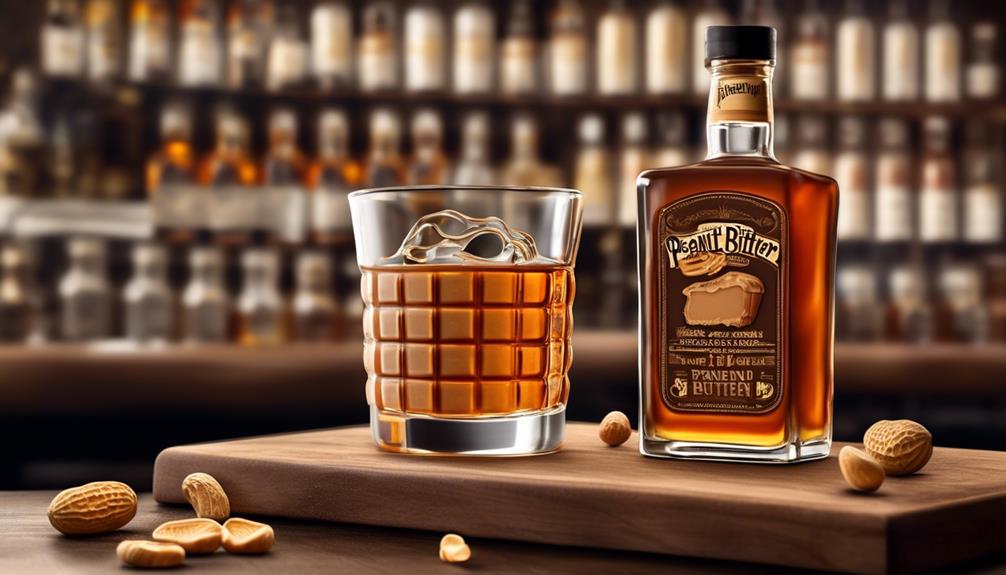
As we continue our exploration of peanut butter whiskey's unique qualities, it's important to understand the alcohol content of this distinct spirit and how it sets it apart from traditional whiskeys.
Unlike typical American whiskey, peanut butter whiskey is known for its lower alcohol percentage, ranging from 30 to 35%, approximately 70 proof, which is notably lower than traditional whiskey's 80 proof. While this places it outside the classification of Scotch whisky according to EU standards, peanut butter whiskey doesn't make such claims.
Despite its lower alcohol by volume (ABV), the whiskey flavored with peanut butter has gained popularity due to its exceptional taste, appealing particularly to those who prefer sweeter alcohol or who previously believed they didn't enjoy whiskey.
For those interested in understanding the alcohol content of different brands, Bartendr provides a comprehensive guide, offering a roundup of the most common peanut butter whiskey brands and their alcohol percentages. This knowledge is crucial for consumers to make informed decisions before purchasing or selecting serving sizes.
Understanding the distinctive alcohol content of peanut butter whiskey is essential to fully appreciate its unique qualities and make the most of this flavorful spirit.
Serving Suggestions and Pairings
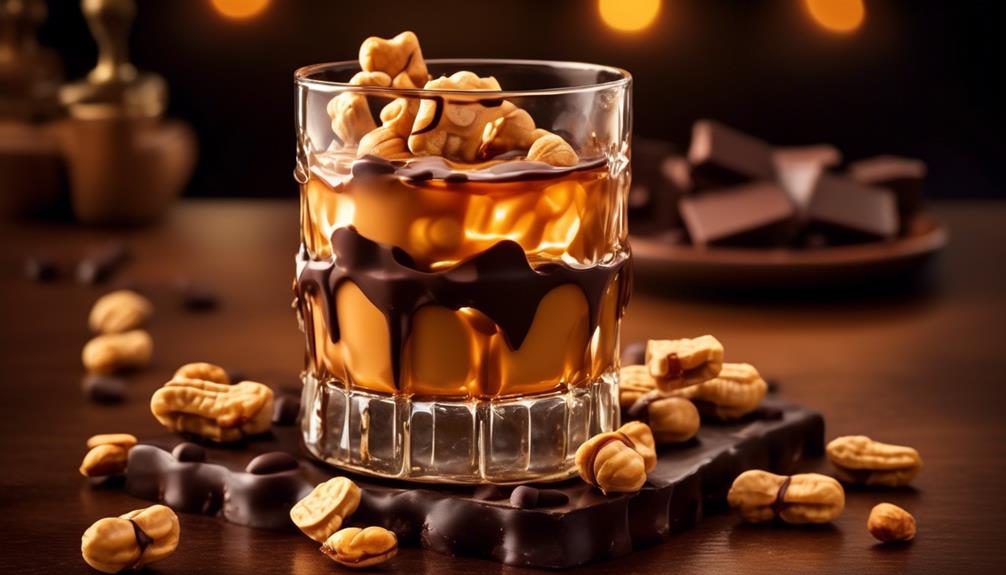
When considering serving suggestions and pairings for Skrewball Peanut Butter Whiskey, various options allow for a versatile and enjoyable drinking experience. Skrewball can be savored neat, on the rocks, or with a splash of water, enhancing its delightful aromatics and flavors.
Additionally, the whiskey can be paired with jammy cassis for a delightful enhancement of fruity flavors, or added to an old-fashioned cocktail for a nutty twist. For those seeking to experiment, mixing Skrewball with alcohols like RumChata, vanilla vodka, and caramel liqueur offers rich and complementary flavors.
Alternatively, trying it with coffee, Coca-Cola, apple cider, berry-flavored seltzer, or chocolate milk provides unique one-ingredient mixers. The versatility of Skrewball opens up new possibilities for whiskey enthusiasts to explore and enjoy creative cocktail combinations.
For further inspiration, the Skrewball website offers additional serving suggestions and cocktail recipes to elevate your next drink with this distinctive flavored whiskey. With these options, Skrewball Peanut Butter Whiskey promises an exciting and flavorful drinking experience.
Exploring Popular Peanut Butter Whiskey Brands

With the rise in popularity of flavored whiskies, a new category has emerged, introducing unique and unconventional flavors to the market. Among these, peanut butter whiskey has garnered significant attention. One of the most popular brands in this category is Skrewball Peanut Butter Whiskey, which has made a mark with its genuine peanut butter aroma and taste. This American whiskey flavored with peanut butter has gained a devoted following due to its unconventional yet enjoyable drinking experience. Created by Steven Yeng and his wife Brittany in San Diego, this flavored whiskey has experienced remarkable growth, evidenced by a staggering 1,976% increase in 2021 and its subsequent acquisition by drinks giant Pernod Ricard in 2023.
The rise of Skrewball Peanut Butter Whiskey also reflects the expanding flavored whiskey market in the United States, with major brands like Fireball, Jim Beam, and Jack Daniels venturing into this space. Skrewball, made with a base of corn and barley, infused with natural flavors, has become renowned for its refusal to provide extensive technical information, emphasizing its unique flavor profile. This versatile whiskey can be enjoyed on its own, mixed in cocktails, or paired with various flavors, offering a creative and adaptable drinking experience.
Making the Most of Skrewball Whiskey
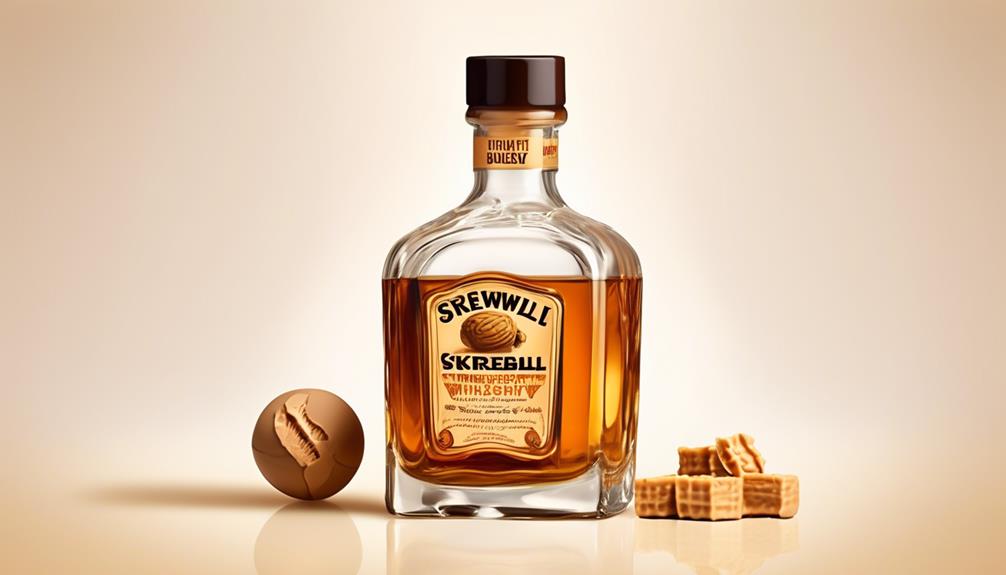
Exploring the versatility and unique flavor profile of Skrewball Peanut Butter Whiskey allows for a delightful and adaptable drinking experience, making it a standout choice in the flavored whiskey market. Skrewball isn't only a delightful sipping whiskey but also a versatile ingredient for crafting innovative cocktails.
Here's how to make the most of Skrewball Whiskey:
- Mixology Mastery: Experiment with Skrewball in classic cocktails like Old Fashioneds or create your own unique concoctions to elevate your mixology skills.
- Decadent Desserts: Infuse your desserts with the rich, nutty flavor of Skrewball, adding a delightful twist to your culinary creations.
- Liquor Store Finds: Seek out Skrewball at your local liquor store and explore the endless possibilities it offers for your home bar.
- Unconventional Pairings: Pair Skrewball with unexpected flavors like chocolate, banana, or even chili for an adventurous tasting experience.
- Whiskey-Flavored Adventures: Take your taste buds on a journey by incorporating Skrewball into your next whiskey tasting session, and savor its unique aroma and taste.
Skrewball Peanut Butter Whiskey opens up a world of flavor possibilities, perfect for those seeking a departure from traditional whiskey experiences.
Mixing and Cocktail Recipes
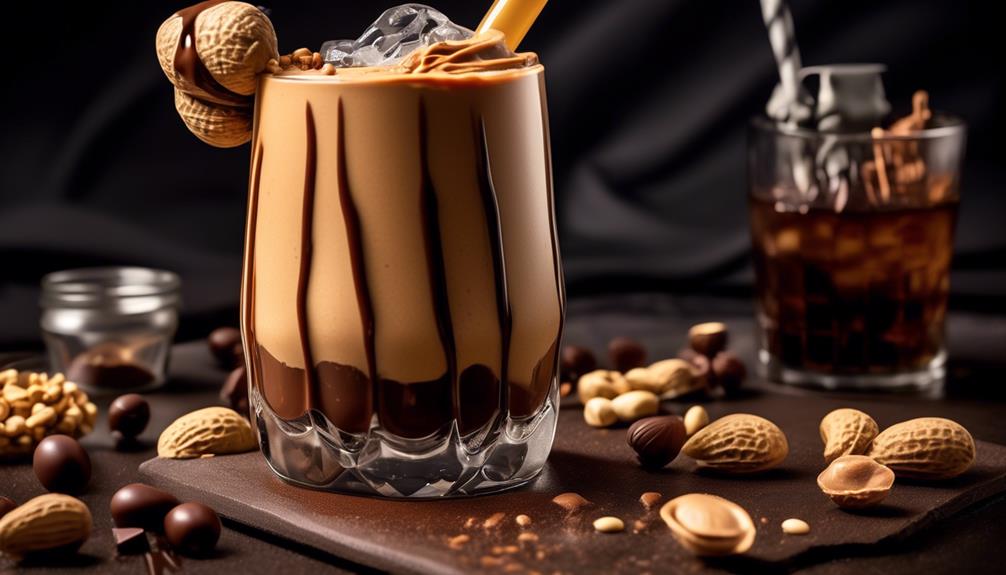
Let's dive into the art of mixing and crafting delectable cocktail recipes using Skrewball Peanut Butter Whiskey, adding a unique twist to traditional libations. Skrewball Peanut Butter Whiskey offers a delightful combination of whiskey flavored with the nutty richness of peanut butter, allowing for the creation of innovative cocktail recipes that tantalize the taste buds. Experimenting with mixing Skrewball with ingredients like jammy cassis, old-fashioned mixers, or complementary spirits such as RumChata and vanilla vodka can result in rich and distinct flavors. The versatility of Skrewball enables the crafting of unique cocktails, including the Graper Manhattan or the Peanut Butter and Honey Old-Fashioned (Winnie's Cup). When mixing Skrewball, it's crucial to consider its sweetness and balance it with other flavors to create well-rounded and enjoyable cocktails. For further inspiration, Skrewball's website offers a variety of well-balanced cocktail recipes, providing guidance for those looking to explore the distinct flavor profile of peanut butter whiskey in mixed drinks.
| Mixing Ideas | Cocktail Recipes |
|---|---|
| Jammy Cassis | Graper Manhattan |
| Old-Fashioned Mixers | Peanut Butter and Honey Old-Fashioned |
| Complementary Spirits (RumChata) | – |
Where to Find Peanut Butter Whiskey

We can easily find popular brands of peanut butter whiskey at our local liquor stores, such as Skrewball, Sheep Dog, and Ole Smoky.
If we prefer the convenience of online shopping, various retailers and alcohol delivery services offer peanut butter whiskey for purchase and delivery.
Additionally, Total Wine is a great option for those seeking a diverse selection of peanut butter whiskey, while specific venues like OB Noodle House Bar 1502 in San Diego may offer the original Skrewball peanut butter whiskey.
Popular Brands Available
Peanut butter whiskey has gained popularity in recent years, with several notable brands like Skrewball, Sheep Dog, and Ole Smoky entering the flavored whiskey market and becoming readily available at liquor stores across the U.S.
- Skrewball Peanut Butter Whiskey offers a genuine peanut butter aroma and taste, providing a unique drinking experience.
- The market has seen significant growth, with major brands like Skrewball, Sheep Dog, and Ole Smoky entering the flavored whiskey market.
- You can find peanut butter whiskey at practically any liquor store in the U.S. and online through retailers like Total Wine.
- Peanut butter whiskey typically has a lower alcohol percentage, around 30-35% ABV, making it sweeter and suitable for mixed drinks.
- Skrewball Peanut Butter Whiskey can be enjoyed alone, in cocktails, or paired with complementary flavors, offering new possibilities for whiskey enthusiasts.
Online and Local Stores
With the growing availability of peanut butter whiskey at both online and local liquor stores, enthusiasts can easily explore a wide range of popular brands such as Skrewball, Sheep Dog, and Sqrrl, as well as other lesser-known options. Check out the table below to discover where you can find these delectable bottles:
| Store | Online Availability | Physical Locations |
|---|---|---|
| Total Wine | Yes | Yes |
| OB Noodle House | No | Yes (San Diego) |
| Bartendr | Yes | No |
| Local Liquor Stores | Varies | Yes |
Peanut butter whiskey, a creation often likened to the nostalgic flavors of peanut butter and jelly, is now easily accessible for both online and in-store purchases. Whether you're seeking the original Skrewball peanut butter whiskey that's a San Diego specialty or looking to explore new flavors like raspberry liqueur-infused options, the options are plentiful. Steven Yeng's innovative fusion of whiskey and peanut butter has truly revolutionized the spirit market.
Specialty Liquor Shops
Exploring specialty liquor shops allows enthusiasts to discover a diverse selection of peanut butter whiskey brands and unique variations, offering a rich opportunity for expanding one's palate and exploring the world of flavored spirits. When seeking out peanut butter-flavored whiskey, specialty liquor shops are an ideal destination due to their distinct advantages:
- They often carry a range of peanut butter whiskey brands, including popular options like Skrewball, Sheep Dog, Ole Smoky, and Skatterbrain.
- Many offer online purchasing and delivery options for convenient access.
- Some stock exclusive or limited edition peanut butter whiskey variations.
- Knowledgeable staff can offer guidance on selection, serving suggestions, and cocktail recipes.
- Visiting provides an opportunity to explore other unique flavored spirits, expanding one's palate beyond peanut butter whiskey.
Frequently Asked Questions
Does Peanut Butter Whiskey Taste Good?
Tastes vary, but we find peanut butter whiskey to be surprisingly delicious. It offers a unique blend of genuine peanut butter flavor and a hint of whiskey bite, making it an enjoyable and versatile spirit.
Its boozy lift complements creative cocktail combinations, and the subtle buttery pastry notes add complexity. While it may not suit everyone's taste, it's a milder option at around 30 to 35% alcohol, making it appealing to those who prefer sweeter alcohol or thought they didn't like whiskey.
Can You Drink Peanut Butter Whiskey Straight?
Absolutely, you can drink peanut butter whiskey straight. The rich, nutty flavor of the whiskey shines through when sipped neat, creating a smooth and indulgent experience. It's a great way to fully appreciate the unique taste profile of the spirit.
The creamy texture and hints of roasted nuts make it a delightful choice for savoring on its own.
How Is Skrewball Peanut Butter Whiskey Made?
Skrewball Peanut Butter Whiskey is made with a blend of corn and barley, infused with natural flavors, giving it an authentic peanut butter taste and aroma. Details of its production, like age statement, aren't disclosed.
It's a versatile spirit, enjoyable on its own or in cocktails, offering a fun and unique flavor profile. It pairs well with flavors like cassis and chocolate, providing a nutty twist to classic cocktails.
Is Skrewball Actually Good?
Oh, Skrewball Peanut Butter Whiskey? It's a game-changer.
The genuine peanut butter flavor and aroma set it apart, making it a delightful surprise for the palate.
The smooth, versatile nature of Skrewball makes it great for sipping on its own or getting creative with cocktails.
Its popularity and market relevance speak volumes about its quality.
Trust us, it's a winner.
Conclusion
In a world full of traditional whiskeys, peanut butter whiskey stands out as a unique and flavorful option. Its rich and smooth taste, reminiscent of a childhood favorite, offers a nostalgic and comforting experience.
Just like spreading peanut butter on warm toast, peanut butter whiskey brings warmth and comfort to any occasion. It's a symbol of creativity and innovation in the world of spirits, and a must-try for anyone looking to add a twist to their whiskey collection.
From sneaky childhood butter licks to penning some of our most popular articles, Jamie’s journey with butter has been lifelong. His culinary background gives him a unique perspective, allowing him to craft mouthwatering articles that educate and tantalize equally. Jamie’s travel adventures revolve around finding the world’s best buttery treats when he isn’t writing.
Peanut Butter
Exploring Peanut Butter Price Trends: Factors Impacting Cost
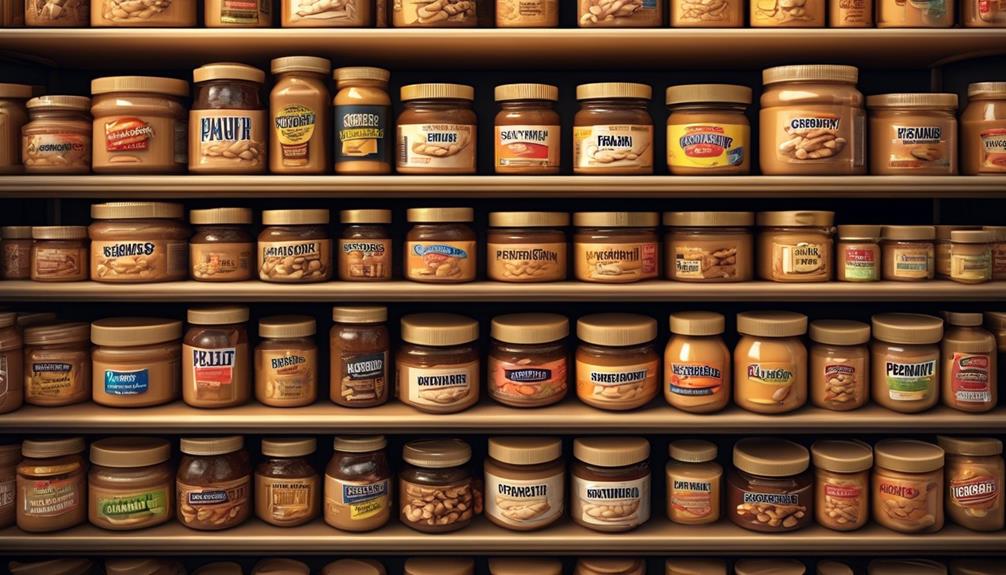
We've all experienced the sticker shock at the grocery store when we reach for our favorite jar of peanut butter, only to find that the price has increased yet again. It leaves us wondering, why is peanut butter so expensive?
Well, there are several factors at play that contribute to the price of this beloved spread. From the cost of peanuts themselves to the impact of market demand and branding, the reasons behind the price of peanut butter might surprise you.
Let's explore the various factors that make peanut butter price what it is and uncover the complexities behind this pantry staple.
Key Takeaways
- Adverse weather conditions and reduced peanut production are contributing factors to the increase in peanut butter pricing.
- High demand for peanut butter among health and fitness enthusiasts is driving up its price.
- Marketing efforts and branding strategies play a role in the higher pricing of peanut butter.
- Packaging and perceived value also impact the pricing of peanut butter.
Factors Affecting Peanut Butter Pricing
Experiencing a shortage due to sweltering temperatures and smaller crops, peanut butter pricing is being affected by various factors in the market.
The Peanut Belt states of Georgia and Texas, which usually yield substantial peanut crops, have been hit by adverse weather conditions, leading to a decrease in peanut production. This scarcity has a direct impact on peanut butter prices, as the reduced supply drives up costs for manufacturers. Companies such as J.M. Smucker Co. are already planning to raise prices in response to the smaller crop, further contributing to the increase in peanut butter pricing.
Additionally, the high demand for peanut butter, fueled by its popularity among health and fitness enthusiasts, as well as shifting consumer preferences, has played a significant role in driving up its cost. Furthermore, the marketing efforts and branding strategies employed by peanut butter companies to stand out in the competitive peanut butter market have also contributed to the higher pricing of peanut butter.
The cost of storing and handling peanuts, including additional expenses for proper storage and transportation, further influences the pricing of peanut butter.
These multiple factors combined have led to the current state of peanut butter prices, making it essential for consumers to find peanut butter that fits within their budget.
Influence of Market Demand
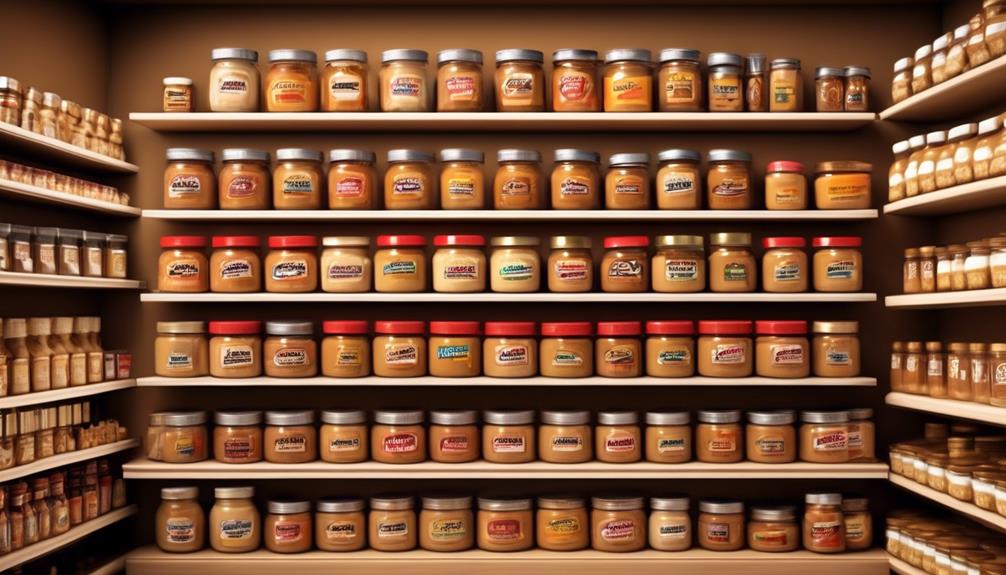
The high demand for peanut butter, driven by its popularity among health and fitness enthusiasts, significantly influences its market pricing. As the demand for peanut butter rises, so does its price. This increase in demand has a direct impact on the cost of peanut butter, driving it up as suppliers and producers seek to capitalize on the market trend.
This is evident in the current pricing, where peanut butter prices have risen by several cents per unit due to the surge in demand. The market demand for peanut butter not only affects its retail cost but also influences various factors contributing to its pricing, such as production, marketing, and distribution.
Additionally, the competitive nature of the market further propels the pricing of peanut butter, as brands invest heavily in marketing to differentiate themselves, passing on these costs to consumers. Moreover, limited availability in certain regions due to imports results in higher transportation and importation costs, further elevating the price of peanut butter.
Therefore, the influence of market demand plays a pivotal role in determining the price of peanut butter, affecting consumers' purchasing power and consumption patterns.
Impact of Branding on Price

When considering the impact of branding on the price of peanut butter, it's crucial to analyze the relationship between brand reputation and pricing.
Packaging plays a significant role in shaping consumers' perceived value of the product, which directly influences pricing strategies.
Additionally, the influence of advertising on consumer perception and pricing strategy can't be overlooked.
Brand Reputation and Price
Brand reputation significantly influences the pricing of peanut butter. Market-dominating brands like J.M. Smucker Co. are able to command higher prices due to their strong brand recognition and reputation. This is because their brand reputation gives consumers the perception of quality and reliability, allowing them to justify paying a premium price. The cost of marketing efforts, including sophisticated branding and organic credentials, is passed on to consumers, further impacting the price of peanut butter.
However, for consumers looking to avoid paying premium prices associated with fancy branding, store brands or budget options offer a more affordable alternative. These brands often have lower marketing costs, allowing them to offer peanut butter at a lower price point.
In addition to brand reputation, there are other factors that contribute to the overall price of peanut butter. The cost of ensuring peanuts are stored correctly, transportation and importation costs, and the manufacturing process all play a role in determining the final price. These costs are influenced by brand reputation and the associated production and handling costs.
Even within leading brands like Jif and Skippy, there are different pricing strategies. Wholesale clubs, for example, often offer competitive prices for both generic and name brand peanut butter. This illustrates the impact of brand reputation on pricing within the market.
Packaging and Perceived Value
Analyzing the impact of packaging on perceived value reveals the intricate relationship between branding and pricing in the peanut butter market.
- Packaging creates a visual and psychological connection, influencing consumers' perception of quality and value.
- Branding and packaging convey a story and lifestyle, enticing consumers to associate higher value with certain brands.
- Innovative and sustainable packaging designs can elevate the perceived value, justifying premium pricing for peanut butter products.
The packaging of peanut butter plays a pivotal role in shaping consumers' perception of its value. It serves as a tangible representation of the brand and its quality, influencing purchasing decisions. As consumers, we're drawn to packaging that communicates quality and aligns with our values, ultimately impacting the price we're willing to pay for peanut butter.
Advertising and Pricing Strategy
The impact of packaging on perceived value in the peanut butter market underscores the significance of advertising and branding efforts in shaping pricing strategies for different brands.
As companies invest in marketing to differentiate themselves and appeal to health-conscious consumers, these efforts significantly influence the pricing of peanut butter. The costs associated with marketing and branding are ultimately passed on to the buyers, contributing to the overall price of peanut butter. This phenomenon makes store brands or budget options an attractive cost-saving alternative for price-conscious consumers.
Additionally, the effective communication of product benefits and unique selling propositions through advertising can justify premium pricing for certain brands. Therefore, advertising and branding play a pivotal role in determining the perceived value of peanut butter, enabling companies to implement diverse pricing strategies to cater to varying consumer segments and preferences.
Cost of Peanuts Storage

Proper storage and transportation of peanuts significantly impact their quality and directly influence the pricing of peanut butter. The cost of ensuring peanuts are stored correctly is reflected in the pricing of peanut butter. Careful handling and storage are necessary to maintain the quality of peanuts. The high fat content of peanuts makes them difficult to store, requiring specific conditions to prevent spoilage.
The proper storage and transportation of peanuts incur additional costs for manufacturers. Incorrectly stored peanuts develop a chemical-like smell and taste bitter or sour, making them unsuitable for peanut butter production. These factors emphasize the importance of investing in adequate storage facilities and transportation methods to maintain the integrity of the peanuts used in peanut butter production.
The cost of peanuts storage is a crucial aspect that directly impacts the overall price of peanut butter. Manufacturers must bear the expenses associated with maintaining optimal storage conditions to ensure the peanuts' quality, which inevitably influences the final pricing of peanut butter for consumers.
Import Challenges for Peanut Butter

Importing peanut butter from countries with limited peanut cultivation presents significant challenges, impacting transportation costs and availability. Limited peanut cultivation in certain countries leads to a heavy reliance on imports, resulting in increased transportation and importation costs. Additionally, importing peanut butter from countries with different growing conditions can lead to higher prices due to limited availability and increased demand. This directly affects the price and accessibility of peanut butter in the United States, making it challenging for some regions to obtain at a reasonable cost.
Expats living abroad often face difficulties in obtaining peanut butter due to limited availability and higher costs of imported peanut butter. As a result, they often rely on friends and family to bring peanut butter when visiting. The availability and demand for peanut butter in different countries further complicate the import challenges, ultimately leading to increased prices for consumers. The additional expenses incurred in the transportation and importation processes contribute to the overall price of peanut butter in the market.
Manufacturing Process Costs
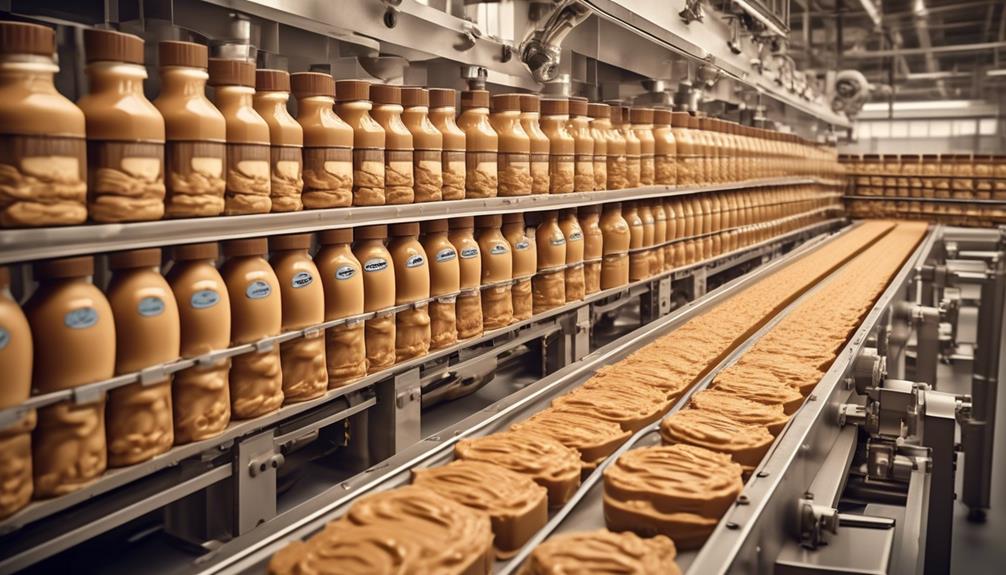
The manufacturing process costs of peanut butter are a crucial aspect of pricing analysis.
Ingredient sourcing and packaging expenses play a significant role in determining the overall manufacturing costs.
We must carefully examine these specific points to understand the impact on the pricing of peanut butter.
Ingredient Sourcing
Investing in equipment, research, and development to meet consumer demands for quality and variety adds to the manufacturing process costs of peanut butter. The sourcing of raw nuts like peanuts significantly impacts these costs. Factors such as crop yield, careful handling, and storage needs influence the overall manufacturing expenses.
Additionally, the cost of transporting and importing peanuts for peanut butter production contributes to the total manufacturing process costs. Furthermore, the cost of raw materials and production processes varies across different nut butters, with factors like the cost of growing and processing peanuts versus almonds contributing to overall price differences.
Understanding these intricacies illuminates the multifaceted nature of peanut butter and nut butter pricing, providing insight into the complexities involved in the ingredient sourcing process.
Packaging Expenses
Careful consideration of packaging expenses is crucial for manufacturers to maintain product quality and appeal to consumers while managing production costs.
Packaging expenses encompass the costs associated with designing, manufacturing, and labeling the containers used to store and sell products like peanut butter and jelly. These costs include materials such as glass, plastic, or metal, as well as the labor and machinery needed for the packaging process.
Additionally, packaging expenses involve the development of attractive and informative labels to appeal to consumers and comply with regulations.
Efficient and sustainable packaging solutions can help minimize expenses and reduce environmental impact, benefitting both the manufacturer and the consumer.
When it comes to a jar of peanut butter or homemade peanut butter, smart packaging decisions can significantly impact the overall cost and consumer perception.
Homemade Vs. Store-Bought Peanut Butter

When considering the decision between homemade and store-bought peanut butter, consumers can weigh the advantages and disadvantages of each option to make an informed choice.
Homemade peanut butter allows for control over ingredients and customization, offering a healthier alternative to store-bought options that may contain added sugars and preservatives. On the other hand, store-bought peanut butter provides convenience and a variety of flavors, catering to diverse consumer preferences.
Additionally, homemade peanut butter can be less expensive, especially when using bulk nuts, compared to premium store-bought options, contributing to cost savings without compromising quality.
In weighing the decision between homemade and store-bought peanut butter, consumers should consider their priorities, whether it's the desire for healthier ingredients, flavor variety, or cost-effectiveness. These factors can guide individuals towards the option that best aligns with their preferences and values.
Frequently Asked Questions
Why Is Peanut Butter so Expensive Now?
Peanut butter is so expensive now due to a combination of factors.
Sweltering temperatures and drought have led to a decreased peanut crop, causing a shortage.
The dominant market player plans to raise prices by 30% due to the shortage.
High demand, sophisticated branding, and marketing efforts also contribute to the increased cost.
Additionally, the cost of storing, handling peanuts, and the manufacturing process adds to the overall price.
Why Is There a Peanut Butter Shortage?
The peanut butter shortage stems from a 13% smaller peanut crop caused by extreme heat and parched soil in the Peanut Belt states.
This shortage has prompted major players like J.M. Smucker Co. to forecast a 30% price increase in November.
High demand, especially from health and fitness enthusiasts, has further driven up costs.
Additionally, the branding and marketing efforts of companies, as well as the costs of storing and handling peanuts, all contribute to the pricing of peanut butter.
Why Are Peanuts so Expensive 2023?
Peanuts are expensive in 2023 due to a combination of factors. Crop damage from extreme weather conditions has reduced harvest sizes, leading to a scarcity of peanuts. Major companies dominating the market have driven up prices. High demand, influenced by popularity and health benefits, has also played a role.
Additionally, costs related to branding, marketing, and production processes contribute to the expensive nature of peanuts.
Why Is Jif so Expensive?
We believe Jif is expensive due to multiple factors.
The 13% decrease in this year's peanut crop, sweltering temperatures, and parched soil in Peanut Belt states like Georgia and Texas have impacted production.
J.M. Smucker Co., dominating 45% of the peanut butter market, expects to raise prices by 30% in November.
Additionally, high demand, marketing efforts, and the cost of storing and handling peanuts contribute to the overall expense of Jif.
Conclusion
In conclusion, the price of peanut butter is influenced by a complex interplay of factors, much like a symphony orchestra with each instrument playing a crucial role in creating the final masterpiece.
From the cost of peanuts to the impact of market demand and branding, every component contributes to the overall price.
Understanding these factors can help consumers make informed decisions and appreciate the value behind their favorite spread.
From sneaky childhood butter licks to penning some of our most popular articles, Jamie’s journey with butter has been lifelong. His culinary background gives him a unique perspective, allowing him to craft mouthwatering articles that educate and tantalize equally. Jamie’s travel adventures revolve around finding the world’s best buttery treats when he isn’t writing.
Peanut Butter
Why Is Peanut Butter a Good Source of Protein?

Peanut butter, like a reliable friend, has always been a staple in our pantry. There's something about its creamy texture and nutty flavor that makes it a versatile and beloved addition to many dishes.
But what exactly makes peanut butter so good? Well, there are several reasons why this humble spread has earned its reputation as a nutritional powerhouse. From its protein content to its heart-healthy fats, there's a lot to unpack when it comes to the benefits of peanut butter.
Key Takeaways
- Peanut butter is a nutritious spread that offers a wide range of health benefits.
- It is a good source of protein, essential amino acids, healthy fats, and essential nutrients like vitamin E, magnesium, and potassium.
- Peanut butter contributes to daily fiber intake, aids in digestion, and promotes a feeling of fullness.
- It contains antioxidants that protect cells from oxidative stress and may lower the risk of cancer and heart disease.
Nutritional Benefits
Peanut butter offers a plethora of nutritional benefits, making it a valuable addition to a balanced diet. When considering the health aspect, it's important to select peanut butter brands that prioritize natural ingredients without added sugars or hydrogenated oils.
The inclusion of peanuts, a heart-healthy nut, provides a good source of protein and essential amino acids crucial for muscle repair and growth. Moreover, the healthy fats present in peanut butter, such as monounsaturated and polyunsaturated fats, play a pivotal role in supporting heart health and lowering bad cholesterol levels, ultimately reducing the risk of heart disease.
Additionally, the abundance of essential nutrients like vitamin E, magnesium, and potassium in peanut butter contributes to overall health and wellness. The high fiber content not only aids in digestion but also promotes a feeling of fullness, which can contribute to weight management. However, it's vital to consume peanut butter in moderate amounts due to its calorie density.
Healthful Fats and Proteins
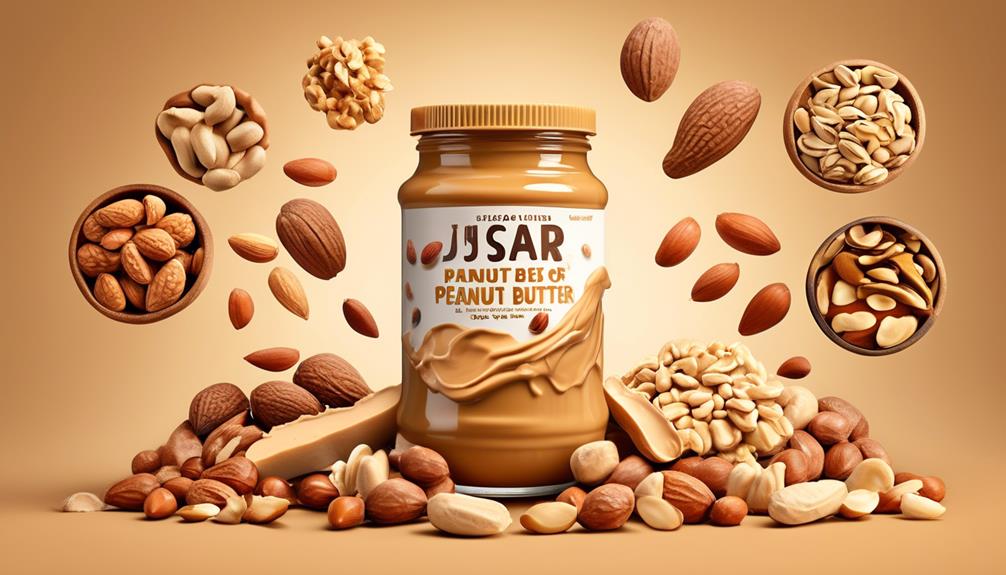
Rich in essential fatty acids, antioxidants, and monounsaturated fats, peanut butter is a valuable source of healthful nutrients that contribute to heart health and overall well-being. The fats in peanut butter include both omega-6 fatty acids and monounsaturated fats, which are beneficial for heart health. While it's high in fat, the majority is monounsaturated fat, which can help reduce the risk of heart disease when consumed as part of a balanced diet.
Additionally, the protein content in peanut butter is substantial, making it a satisfying and filling option. Protein not only aids in muscle repair and growth but can also help control blood sugar levels and appetite. By choosing natural or organic peanut butter without added sugars and trans fats, individuals can maximize the health benefits, including essential vitamins and minerals.
Incorporating peanut butter into meals and snacks can offer a delicious way to consume healthful fats and protein, contributing to overall well-being.
Vitamin and Mineral Content
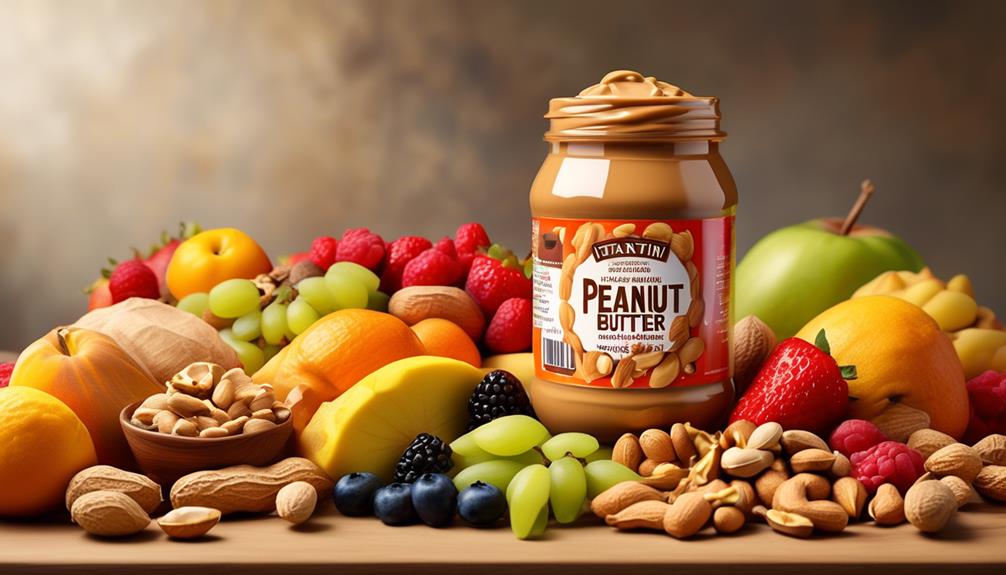
Peanut butter is a nutrient-rich spread that offers essential vitamins and minerals.
A 2-tablespoon serving provides approximately 2 mg of vitamin E, 49 mg of magnesium, and 208 mg of potassium.
Additionally, it contains niacin and small amounts of zinc, contributing to energy production, metabolism, immune function, and wound healing.
Nutrient-Rich Spread
Containing a wealth of essential vitamins and minerals such as vitamin E, magnesium, and potassium, peanut butter is a nutrient-rich spread that contributes to a balanced diet and supports overall wellness.
Peanut butter is a good source of protein, essential amino acids, and healthy fats, making it beneficial for muscle repair, immune system function, and weight loss.
The heart-healthy monounsaturated and omega-6 fatty acids in peanut butter may lower the risk of developing heart disease.
Moreover, the vitamin E content in peanut butter supports skin and hair health, while the magnesium and potassium help regulate blood sugar levels.
Incorporating natural or organic peanut butter into a balanced diet can provide these essential nutrients and promote overall health.
It's important to be mindful of portion sizes and choose natural varieties to maximize the nutrient benefits of peanut butter.
Essential Vitamins and Minerals
Packed with a plethora of vital nutrients, peanut butter serves as a substantial source of essential vitamins and minerals necessary for maintaining overall health and well-being. It contains protein, fiber, niacin, magnesium, phosphorous, zinc, and vitamin B-6, contributing to a healthful diet. These nutrients support nerve function, insulin sensitivity, and aid in maintaining a healthy weight.
The nutrient profile of peanut butter also includes monounsaturated and polyunsaturated fatty acids, which can reduce the risk of heart disease by lowering bad cholesterol levels. Additionally, the rich antioxidants and essential fatty acids in peanut butter contribute to cell repair, skin health, and protection against oxidative stress.
Despite these benefits, it's crucial to consume peanut butter in moderation due to its high calorie, saturated fat, and sodium content.
Dietary Fiber Contribution
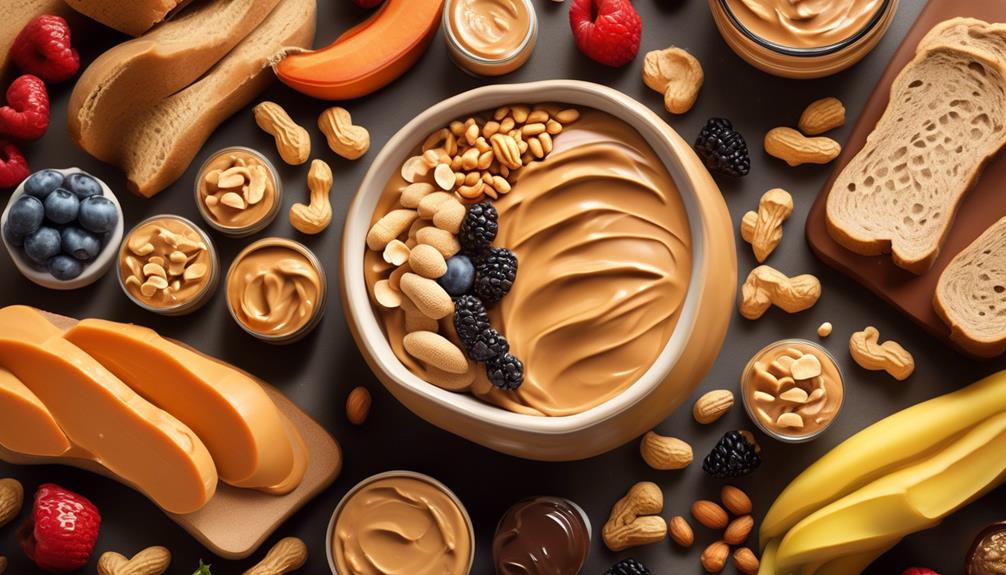
With approximately 2 grams of dietary fiber in a 2-tablespoon serving, peanut butter is a significant contributor to daily fiber intake, promoting digestive health and supporting overall well-being. Peanut butter's high fiber content aids in digestion, promotes a feeling of fullness, and supports the growth of healthy gut bacteria. It helps manage blood sugar levels and lower cholesterol, potentially lowering the risk of heart disease. Including peanut butter in the diet not only adds to the daily fiber intake but also contributes to overall digestive health and regularity. Choosing natural or organic peanut butter options can maximize the dietary fiber contribution while avoiding added sugars and unhealthy fats.
- Peanut butter's high fiber content aids in digestion and promotes a feeling of fullness.
- It supports the growth of healthy gut bacteria, contributing to overall digestive health.
- The dietary fiber in peanut butter can help manage blood sugar levels and lower cholesterol, potentially lowering the risk of heart disease.
- Choosing natural or organic peanut butter options maximizes the dietary fiber contribution while avoiding added sugars and unhealthy fats.
Antioxidant Properties
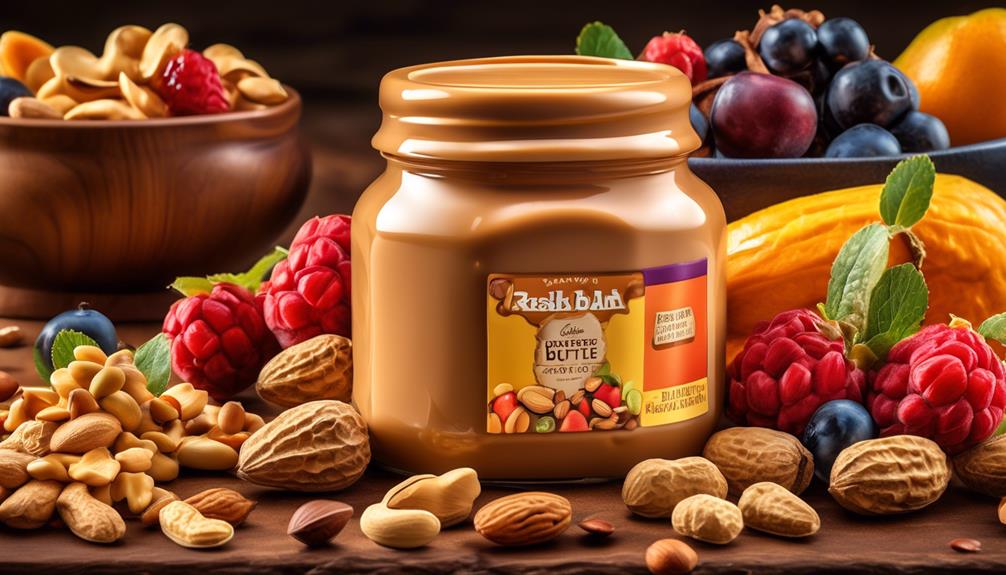
The antioxidant properties of peanut butter are worth exploring, as they play a significant role in promoting overall health.
The presence of antioxidants, such as vitamin E and resveratrol, in peanut butter may contribute to reducing the risk of chronic diseases.
These antioxidants help protect the body's cells from free radical damage, offering potential benefits in disease prevention and free radical defense.
Health Benefits
Containing antioxidants such as vitamin E and p-coumaric acid, peanut butter plays a significant role in combating oxidative stress and protecting cells from damage, thereby contributing to reducing the risk of chronic diseases such as heart disease and certain types of cancer.
Regular consumption of peanut butter is a good option for promoting overall health, as its antioxidant properties support the body's defense against free radicals and inflammation. This may help reduce your risk of heart disease and certain types of cancer.
Additionally, a high intake of peanut butter may contribute to a lower risk of chronic diseases. It's important to note that while peanut butter is healthy due to its antioxidant content, it's high in calories, so moderation is key.
Always consult a healthcare professional for diagnosis or treatment.
Disease Prevention
Taking into account its potent antioxidant properties, peanut butter plays a crucial role in preventing diseases and promoting overall health.
Studies have shown that peanut butter, with its high antioxidant content, can help prevent oxidative stress and reduce the risk of chronic diseases. The antioxidants in peanut butter contribute to maintaining good cholesterol levels, blood sugar levels, and blood pressure, making individuals less likely to develop heart disease.
Furthermore, the presence of antioxidants in peanut butter may lower the risk of cancer and promote cell repair. Incorporating peanut butter into a balanced diet can help protect against oxidative damage and reduce the risk of developing type 2 diabetes.
Free Radical Defense
Boasting potent antioxidant properties, peanut butter actively defends the body against free radicals, mitigating the risk of cellular damage and chronic diseases. The antioxidants in peanut butter, such as vitamin E and flavonoids, help neutralize free radicals, protecting cells and tissues from oxidative stress. Consuming peanut butter with antioxidant properties may contribute to lower risks of cancer, heart disease, and other chronic conditions by combating free radicals.
Additionally, these antioxidants promote cell repair and enhance the body's defense against oxidative damage, ultimately boosting overall health and well-being. Including peanut butter with antioxidant properties in our diet supports the body's natural defense system, contributing to long-term health.
With its high content of oleic acid and vitamin B, peanuts play a crucial role in safeguarding our health and well-being.
Satiety and Energy Boost
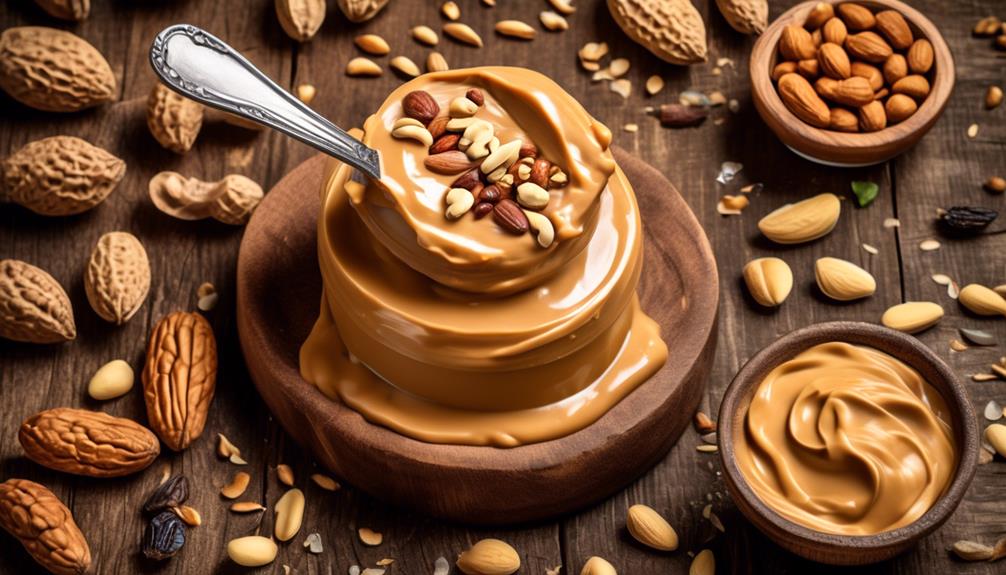
Peanut butter provides a sustained feeling of fullness and a reliable source of energy due to its high protein and healthy fat content. The protein in peanut butter helps to regulate appetite and increase satiety, which can aid in weight management. Additionally, the healthy fats in peanut butter provide a slow-burning source of energy, which can help maintain stable blood sugar levels and prevent energy crashes. This combination of protein and healthy fats makes peanut butter an excellent choice for a satisfying snack or addition to meals.
In terms of health, peanut butter is relatively high in calories, so portion control is important, especially for those watching their calorie intake. However, the fats in peanut butter are predominantly heart-healthy monounsaturated and polyunsaturated fats, which can have a positive impact on cholesterol levels and overall heart health. Peanuts, the main ingredient in peanut butter, also contain various nutrients and antioxidants that contribute to its health benefits.
It's important to note that while peanut butter has numerous health benefits, it's crucial to choose natural varieties without added sugars and excessive salt to minimize potential risks associated with processed foods.
Frequently Asked Questions
What Are the Benefits of Eating Peanut Butter?
Eating peanut butter offers numerous benefits.
It's a rich protein source, aiding muscle repair and growth.
The healthy fats support heart health, lowering the risk of heart disease.
Packed with vitamins and minerals, it contributes to overall well-being.
Its protein-fiber combo aids weight management and appetite control.
Moreover, it helps with blood sugar management, reducing the risk of type 2 diabetes.
Including it in a balanced diet promotes overall health and wellness.
Why Is Peanut Butter so Good?
Peanut butter is good due to its rich protein, healthy fats, and essential nutrients. It's beneficial for heart health, appetite control, and weight management.
Additionally, its versatility makes it a convenient, nutritious option for various recipes and snacks.
When opting for peanut butter, choosing natural or organic varieties without added sugars, oils, or trans fats maximizes its health benefits.
Is Peanut Butter OK to Eat Everyday?
Oh, peanut butter? Absolutely! We make it a daily staple. Packed with protein, healthy fats, and essential nutrients, it's a great addition to our diet.
Research suggests it can improve heart health, regulate blood sugar, and reduce the risk of certain diseases. Just be mindful of portion sizes and opt for natural, sugar-free options.
It's all about balance and moderation.
Why Is a Spoonful of Peanut Butter Good for You?
A spoonful of peanut butter is good for us because it provides a healthy dose of protein, fiber, and essential nutrients like magnesium, phosphorus, and vitamin B-6. This combination supports heart health, helps with appetite control, and can aid in weight management.
Additionally, peanut butter can help regulate blood sugar levels, making it a suitable option for individuals with type 2 diabetes. Its versatility also allows for easy incorporation into various dishes and snacks.
Conclusion
In conclusion, peanut butter offers a wealth of nutritional benefits. It is rich in protein, which is essential for muscle repair and growth. Peanut butter also contains heart-healthy monounsaturated fats. These fats can help improve cholesterol levels and lower the risk of heart disease.
Additionally, peanut butter is a good source of fiber, vitamins, and minerals. The fiber helps with digestion and can promote a feeling of fullness. The vitamins and minerals in peanut butter contribute to overall health and well-being.
Another benefit of peanut butter is its antioxidant properties. Antioxidants help protect the body against damage from harmful free radicals. This added protection can have a positive impact on long-term health.
It is important to note that while peanut butter is nutritious, it should be consumed in moderation. It is high in calories, so excessive consumption can lead to weight gain. However, incorporating peanut butter into a balanced diet can provide a satisfying and energy-boosting addition.
So, next time you enjoy that creamy peanut butter on your toast, remember the array of benefits it brings to your health.
From sneaky childhood butter licks to penning some of our most popular articles, Jamie’s journey with butter has been lifelong. His culinary background gives him a unique perspective, allowing him to craft mouthwatering articles that educate and tantalize equally. Jamie’s travel adventures revolve around finding the world’s best buttery treats when he isn’t writing.
-

 Recipes & Culinary Uses2 months ago
Recipes & Culinary Uses2 months agoHow Many Sticks of Butter Equals a Pound: A Handy Guide
-

 Shopping Guides1 month ago
Shopping Guides1 month agoWhere to Buy Raw Butter
-

 Recipes & Culinary Uses4 weeks ago
Recipes & Culinary Uses4 weeks agoMake Homemade Butter from Milk at Home
-

 Recipes & Culinary Uses4 weeks ago
Recipes & Culinary Uses4 weeks agoMake Creamy Butter From Buttermilk
-

 Butter Tips and Tricks3 months ago
Butter Tips and Tricks3 months agoHow Long Can You Use Butter After the Expiration Date?
-

 Recipes & Culinary Uses2 months ago
Recipes & Culinary Uses2 months agoMake Your Own Homemade Spray Butter
-

 Butter Tips and Tricks3 months ago
Butter Tips and Tricks3 months agoHow Much Butter to Use Instead of 1/3 Cup Oil
-

 Butter Tips and Tricks3 months ago
Butter Tips and Tricks3 months agoHow Many Calories Are in a Stick of Butter: A Comprehensive Guide




















